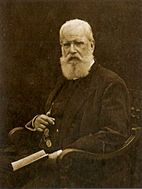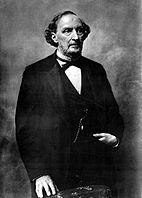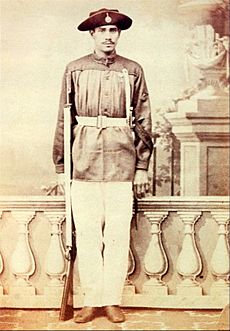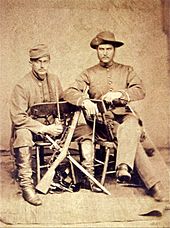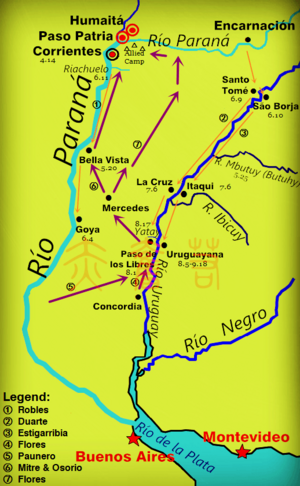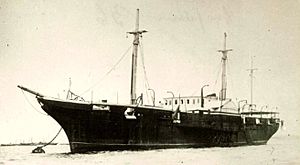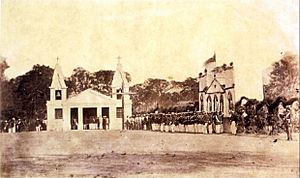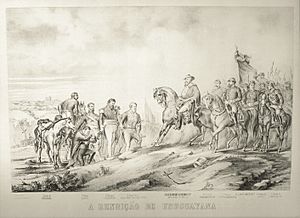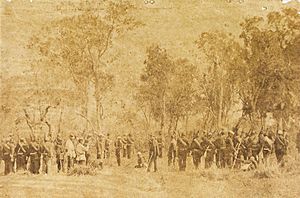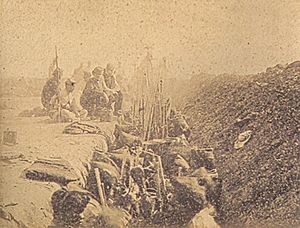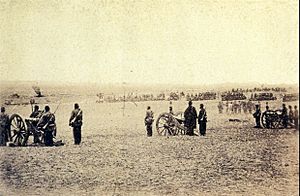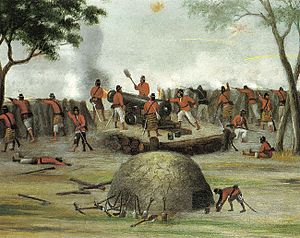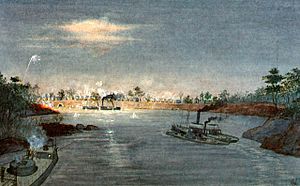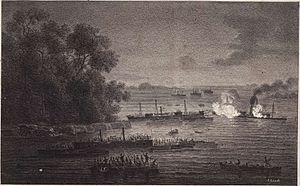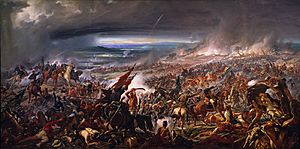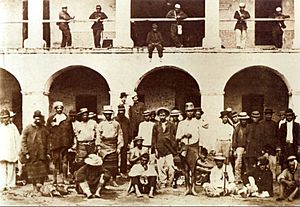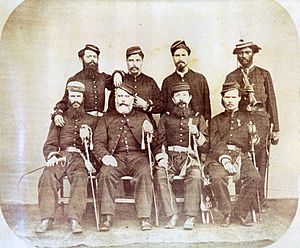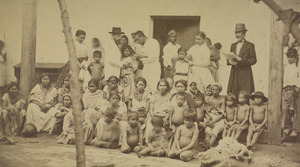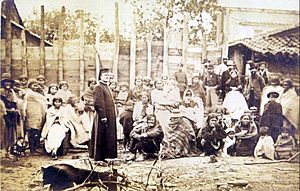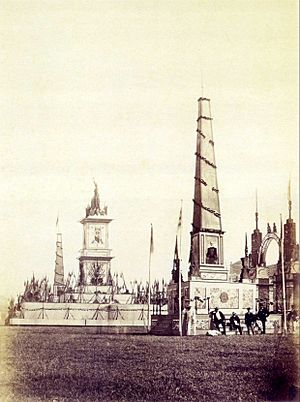Paraguayan War facts for kids
Quick facts for kids Paraguayan War |
|||||||||
|---|---|---|---|---|---|---|---|---|---|
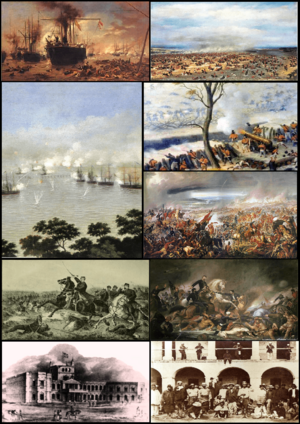 From top, left to right: the Battle of Riachuelo (1865), the Battle of Tuyutí (1866), the Battle of Curupayty (1866), the Battle of Avay (1868), the Battle of Lomas Valentinas (1868), the Battle of Acosta Ñu (1869), the Palacio de los López during the occupation of Asunción (1869), and Paraguayan war prisoners (ca. 1870) |
|||||||||
|
|||||||||
| Belligerents | |||||||||
Co-belligerent: |
|||||||||
| Commanders and leaders | |||||||||
|
|||||||||
| Strength | |||||||||
|
|
||||||||
| Casualties and losses | |||||||||
|
|||||||||
| Total: 150,000–500,000 dead ...further details |
|||||||||
The Paraguayan War, also known as the War of the Triple Alliance, was a major conflict in South America. It lasted from 1864 to 1870. The war was fought between Paraguay and a group of countries called the Triple Alliance. This alliance included Argentina, the Empire of Brazil, and Uruguay.
This war was the deadliest and bloodiest in Latin American history. Many people in Paraguay died, and the exact numbers are still debated. After the war, Paraguay had to give up some land to Argentina and Brazil. The war started in late 1864 because of a fight between Paraguay and Brazil. Argentina and Uruguay joined the war against Paraguay in 1865.
After Paraguay lost most of its regular army, it continued fighting using guerrilla tactics. This type of fighting caused even more damage to Paraguay's military and its people. Many civilians died from fighting, hunger, and sickness. The guerrilla war lasted for 14 months. It ended when Paraguay's President, Francisco Solano López, was killed by Brazilian forces in the Battle of Cerro Corá on March 1, 1870. Argentine and Brazilian troops stayed in Paraguay until 1876.
Contents
- Why the War Started: The Background
- Who Fought: The Armies
- How the War Happened
- How Many People Died: War Casualties
- Changes in Land and Treaties
- What Happened After the War
- How the War Affected Yerba Mate
- Images for kids
- See also
Why the War Started: The Background
Old Border Problems
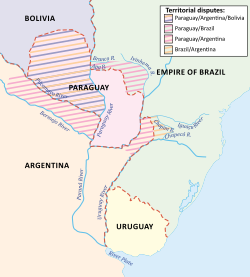
After countries in South America became independent from Spain and Portugal in the early 1800s, they had many arguments over land. Each new country had border problems with its neighbors. This was because the old maps and agreements from Spain and Portugal were not clear. For example, the Treaty of Tordesillas from 1494 was very old and didn't match where people actually lived.
Later, the Treaty of Madrid in 1750 tried to draw better borders. But even then, Spain and Portugal were not happy. More treaties were signed, but the borders remained confusing.
When the Viceroyalty of the Río de la Plata broke apart, new countries like Argentina, Paraguay, Bolivia, and Uruguay appeared. They all argued over lands that were often empty or lived in by native tribes. For Paraguay and Brazil, the main problem was deciding if the Apa River or Branco River should be their border.
Political Tensions Before the War
There are different ideas about how the war began. One main idea is that Paraguay's President, Francisco Solano López, used a conflict in Uruguay as an excuse. He wanted to gain more control in the Platine basin area. This made Brazil and Argentina, who were powerful in the region, react.
The war also happened because of old border fights between the new countries. There was a struggle for power over the important Río de la Plata region. Brazil and Argentina often got involved in Uruguay's politics. Solano López also wanted to help his allies in Uruguay.
Paraguay built a strong army because its bigger neighbors, Argentina and Brazil, had claims on its land. They also wanted to control Paraguay politically. Paraguay had argued about borders and trade with Argentina and Brazil for many years.
Regional Rivalry
Since Brazil and Argentina became independent, they often competed for power in the Río de la Plata region. This greatly affected how countries in the area got along.
Brazil was the first country to recognize Paraguay's independence in 1844. At that time, Argentina still thought Paraguay was part of its own territory. Brazil even helped Paraguay improve its army. They sent officers and technical help to Asunción.
Brazil also needed to use the Paraguay River to reach its inland province of Mato Grosso. But Paraguay made it difficult for Brazilian ships to travel freely on the river.
The Uruguayan Conflict
Brazil had interfered in Uruguay's politics and military three times before. In 1864, Brazil interfered again against the Uruguayan President Atanasio Aguirre. This led to the Paraguayan War.
On April 19, 1863, Uruguayan General Venancio Flores invaded his country. He was part of the Colorado Party, which Brazil supported. Argentina openly helped him with weapons and soldiers. Flores wanted to remove the Blanco Party government, which was allied with Paraguay.
Paraguayan President López asked Argentina for an explanation in September 1863. Argentina denied helping Flores. After this, Paraguay started mandatory military service. By February 1864, 64,000 more men joined the army.
In April 1864, Brazil sent its navy to Uruguay. They demanded money for damages caused by border conflicts. Uruguayan President Aguirre refused and asked Paraguay for help. Solano López offered to help solve the problem, but Brazil said no.
Brazilian soldiers helped Flores' troops. The Brazilian navy put pressure on Montevideo, Uruguay's capital. In June-August 1864, Brazil and Argentina signed a treaty to help each other in the Plate Basin Crisis.
Brazil sent an ultimatum to Uruguay on August 4, 1864. They said if Uruguay didn't agree to their demands, the Brazilian army would attack. Paraguay warned Brazil that any attack on Uruguay would upset the balance of power in the region. Paraguay said it would protest strongly.
Brazil ignored Paraguay's warning and invaded Uruguay on October 12. This was not the start of the Paraguayan War yet. Paraguay still had diplomatic ties with Brazil for another month.
On November 11, the Brazilian ship Marquês de Olinda was traveling up the River Paraguay. It was going to the Brazilian Mato Grosso province. López ordered a Paraguayan ship to chase it and bring it back. On November 13, the Brazilian ship was captured, and everyone on board was arrested. On November 12, Paraguay told Brazil that they were ending diplomatic relations.
The conflict between Brazil and Uruguay ended in February 1865. Brazil was happy, but public opinion changed when newspapers said the peace deal was bad for Brazil. However, the deal actually helped Brazil by making Uruguay an ally against Paraguay.
Who Fought: The Armies
Paraguay's Military
Some historians say Paraguay started the war with over 60,000 trained soldiers. About 38,000 were already armed. They also had 400 cannons and a navy of 23 steamboats.
Rivers were the main way to travel in the Río de la Plata basin. So, Paraguay built strong forts along the lower part of the Paraguay River. This was to control the rivers.
However, newer studies show problems with Paraguay's army. Even though they had many soldiers (70,000 to 100,000), they were not well-equipped. Most soldiers had old, inaccurate muskets that were slow to reload. Their cannons were also poor. Officers had little training, and President López made all the decisions himself. Food, ammunition, and weapons were scarce. Paraguay, with about 450,000 people, was much smaller than the Triple Alliance, which had 11 million people.
Brazil and Its Allies
At the start of the war, Brazil, Argentina, and Uruguay had smaller armies than Paraguay. Argentina had about 8,500 soldiers. Uruguay had fewer than 2,000 men and no navy. Brazil had 16,000 troops, but many were far away.
Brazil's strength was its navy. It had 45 ships with 239 cannons and about 4,000 trained sailors. Many of these ships were already in the Rio de la Plata basin.
Brazil's army was not well-organized. Many Brazilian soldiers were volunteers called Voluntários da Pátria. Some were formerly enslaved people who were freed to fight. They were promised land if they joined the army. The cavalry was made up of National Guard members.
In total, about 146,000 Brazilians fought in the war. This included regular army soldiers, volunteers, National Guardsmen, freed enslaved people, and navy personnel.
How the War Happened
Paraguay's First Attacks
Invading Mato Grosso
Paraguay attacked first. On December 14, 1864, they invaded the Brazilian province of Mato Grosso. Then, in early 1865, they invaded the Rio Grande do Sul province in the south and Argentina's Corrientes Province.
Two Paraguayan forces entered Mato Grosso. One force attacked the Nova Coimbra fort on December 27, 1864. The Brazilian soldiers there fought for three days. But they ran out of ammunition and left the fort. The Paraguayans then took other cities like Albuquerque and Corumbá.
Another Paraguayan group attacked the military post of Dourados. They faced strong resistance but eventually won. The Paraguayans continued to take more towns.
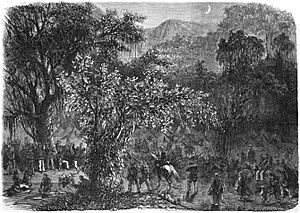
Even with these wins, the Paraguayans did not go to Cuiabá, the capital of Mato Grosso. Their main goal was to capture gold and diamond mines.
Brazil sent an army to fight in Mato Grosso. They marched over 2,000 km, which was very difficult. But by the time they arrived, Paraguay had already left many areas. A large part of Mato Grosso stayed under Paraguayan control. Brazilian troops left the area in April 1868 to focus on the main fighting in southern Paraguay.
Paraguay Invades Corrientes and Rio Grande do Sul
When the war started, Argentina stayed neutral. But Solano López doubted Argentina's neutrality. This was because Argentina let Brazilian ships use its rivers, even though Paraguay was at war with Brazil.
Paraguay needed to cross Argentina to help its allies in Uruguay. In January 1865, Solano López asked Argentina for permission to send 20,000 soldiers through Corrientes province. Argentina's President, Bartolomé Mitre, said no.
After this, the Paraguayan Congress declared war on Argentina on March 23, 1865. They said Argentina was being hostile and helping Brazil. Solano López was made a Field Marshal.
On April 13, 1865, a Paraguayan navy group attacked two Argentine ships. Paraguayan troops then took the city of Corrientes. They advanced south along the river.
Another 12,000 Paraguayan soldiers crossed into Rio Grande do Sul, Brazil, in May 1865. They went down the Uruguay River and took the towns of São Borja and Uruguaiana.
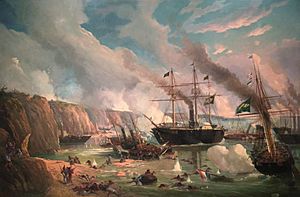
Solano López hoped to get help from an Argentine leader named Justo José de Urquiza. Urquiza was known to be against President Mitre. But Urquiza supported Argentina's fight against Paraguay. The Paraguayan attacks failed.
After Paraguay invaded Corrientes, Argentina declared war on Paraguay on May 4, 1865. President Mitre famously said: "In three days we shall be at the barracks. In three weeks, at the frontiers. And in three months in Asunción!"
On May 1, 1865, Brazil, Argentina, and Uruguay had already secretly signed the Treaty of the Triple Alliance. They named Bartolomé Mitre as the supreme commander of their combined forces.
On June 11, 1865, the Brazilian navy destroyed the Paraguayan navy in the Battle of Riachuelo. This battle was very important. It meant the Triple Alliance now controlled the rivers. This made it very hard for Paraguay to move troops and supplies.
A separate Paraguayan group was defeated by Allied troops in the Battle of Yatay.
Solano López ordered his troops to leave Corrientes. But the Paraguayan troops in Rio Grande do Sul were surrounded at Uruguaiana. On September 18, the Paraguayan soldiers there surrendered without more fighting.
The Allies Fight Back
By the end of 1865, the Triple Alliance was attacking. Their armies had 42,000 foot soldiers and 15,000 cavalry. They invaded Paraguay in April. Paraguay won a small battle, but it did not stop the invasion.
Invading Paraguay
On April 16, 1866, the Allied armies crossed the Paraná River and entered Paraguay. López tried to counter-attack, but he was pushed back. The Allied advance was stopped at the Battle of Estero Bellaco on May 2, 1866.
Solano López then launched a huge attack with 25,000 men against 35,000 Allied soldiers. This was the Battle of Tuyutí on May 24, 1866. It was one of the bloodiest battles in Latin American history. López's plan failed because the Allies fought back fiercely. Both sides lost many soldiers. Paraguay had over 12,000 casualties, and the Allies had 6,000.
By July 18, the Paraguayans recovered and defeated some Allied forces. But Brazilian General Porto Alegre won the Battle of Curuzú. This put the Paraguayans in a very difficult spot.
On September 12, 1866, Solano López met with Allied leaders to talk about peace. López knew the war was lost and wanted to sign a peace treaty. But no agreement was reached. The Allies demanded that López be removed from power, which he refused.
Allied Problems at Curupayty
After the talks, the Allies marched into Paraguay. They reached the strong defensive line of Curupayty. The Allies attacked head-on, thinking their numbers and ships would help. But the Paraguayans, led by General José E. Díaz, held their ground. They caused huge damage to the Allied troops. The Allies had over 8,000 casualties, while Paraguay lost only about 250 men.
The Battle of Curupayty was a terrible defeat for the Allies. It stopped their advance for ten months. The Allied leaders blamed each other for the failure.
Caxias Takes Command
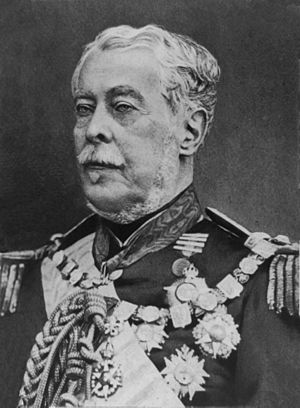
The Brazilian government decided to put one person in charge of all Brazilian forces. They chose 63-year-old Caxias on October 10, 1866. Caxias arrived on November 17. He fired the current navy leader and appointed a new one.
Caxias took full command on November 19. He wanted to stop the arguments among the leaders. When President Mitre left in February 1867, Caxias became the overall commander of the Allied forces. He found the army weak and sick. Caxias trained his soldiers, gave them new weapons, and improved their health care. This stopped the spread of diseases. From October 1866 to July 1867, all attacks stopped. Solano López used this time to make the Fortress of Humaitá even stronger.
The Advance Continues: Humaitá Falls
When the Brazilian army was ready, Caxias decided to surround Humaitá. He used observation balloons to spy on the enemy. On July 22, the Allied army began to move around Humaitá. Caxias wanted to go around the Paraguayan forts, cut off their supplies, and surround them.
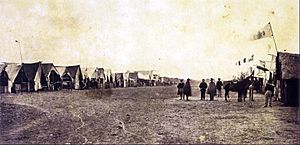
The Allied army kept moving north to surround Humaitá. They reached San Solano and Tayi, cutting off Humaitá from Asunción. On November 3, Solano López attacked the Allied forces from behind.
The Paraguayans captured weapons and supplies. The Allied army recovered thanks to General Porto Alegre. In this battle, Paraguay lost over 2,500 men, while the Allies had about 500 casualties.
By 1867, Paraguay had lost 60,000 men to fighting, injuries, or disease. López had to force more people to join the army, including enslaved people and children. Women helped by doing support tasks. Many Paraguayan soldiers fought without shoes or uniforms. López was very strict and even executed his own family members for supposedly giving up.
By December 1867, there were many Brazilian, Argentine, and Uruguayan soldiers at the front. On January 14, 1868, Mitre left his command for good. Caxias continued to lead the Brazilian army.
On February 19, Brazilian ironclad ships sailed up the Paraguay River. They took control of the river, cutting off Humaitá's water supplies. Humaitá finally fell on July 25, 1868, after a long siege.
López and most of his army escaped from Humaitá. He tried a bold move to capture Allied ironclads.
On March 2, 1868, Paraguayan canoes attacked the Brazilian warships Lima Barros and Cabral. The canoes were disguised with branches and had 50 soldiers each. The fighting lasted until morning. The Paraguayans lost 400 men and 14 canoes.
Asunción Falls
On their way to Asunción, the Allied army stopped at the Piquissiri River. Solano López had gathered 12,000 Paraguayans there in a strong defensive line.
Caxias decided to go around the Paraguayan defenses. He had his army cross to the west side of the river. They built a road through the swamps and advanced. Then they crossed the river again, getting behind the Paraguayan line.
Instead of going straight to the capital, Caxias attacked the Paraguayans from behind in December 1868. This was called the "Dezembrada." Caxias's troops were ambushed while crossing the Itororó River, and the Paraguayans caused heavy damage. But days later, the Allies destroyed a whole Paraguayan division at the Battle of Avay. Weeks later, Caxias won another big victory at the Battle of Lomas Valentinas. He captured the last Paraguayan army stronghold. On December 24, Caxias asked Solano López to surrender, but López refused and fled.
Asunción was taken on January 1, 1869. Caxias entered the city with his army on January 5. Most of Caxias's army stayed in Asunción. By this time, Caxias was sick and tired. He left his command on January 18.
About 30,000 Allied soldiers were in Asunción. For the next few months, they looted almost every building, even those belonging to other countries.
A New Government
With Solano López on the run, Paraguay had no government. Brazil sent its Foreign Minister, José Paranhos, to Asunción. He arrived on February 20, 1869, and started talking with local politicians. Paranhos wanted to create a temporary government that would sign a peace treaty. This government would also recognize the border Brazil wanted.
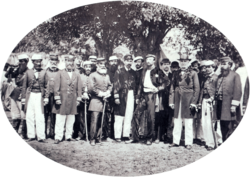
Paraguay was destroyed. Paranhos helped set up a temporary government. On March 31, 335 citizens asked the Allies for a provisional government. After talks, it was agreed that a three-man government would be set up. This government was installed on August 15, but it was really controlled by the Allied occupation. After López died, the Provisional Government promised political freedoms and to help trade and immigration.
This temporary government did not last long. Members resigned, and a new provisional President was chosen.
The Final Fight: Guerrilla Warfare
Campaign of the Hills
Gaston, Count of Eu, the son-in-law of Emperor Pedro II, was put in charge of the final part of the war in 1869. With 21,000 men, he led the fight against the remaining Paraguayan resistance. This was called the Campaign of the Hills. It lasted over a year.
Important battles included the Battle of Piribebuy and the Battle of Acosta Ñu. More than 5,000 Paraguayans died in these battles.
Death of Solano López
President Solano López organized the last resistance in the mountains. By the end of the war, Paraguay had very few weapons and supplies. Solano López was very strict. He ordered soldiers to kill anyone who talked about surrendering. Soldiers fought until the very end.
Two groups of soldiers chased Solano López, who had about 200 men with him. On March 1, 1870, Brazilian troops surprised the last Paraguayan camp in Battle of Cerro Corá. Solano López was wounded and separated from his army. He was too weak to walk.
Brazilian General José Antônio Correia da Câmara arrived. He offered López a chance to surrender and promised to spare his life. But Solano López refused. He shouted, "I die with my homeland!" and tried to attack Câmara. He was quickly killed by Câmara's men. This ended the long war in 1870.
How Many People Died: War Casualties
Paraguay suffered huge losses. Many people died from fighting, hunger, and disease. Some historians believe that most of Paraguay's population was lost. The exact numbers are still debated. Estimates for Paraguay's population before the war range from 300,000 to over 1.3 million.
After the war, a census in 1871 counted 221,079 people in Paraguay. Of these, 106,254 were women, 28,746 were men, and 86,079 were children.
Some reports say up to 90% of the male population was killed. However, this number is not well-supported. One estimate says about 300,000 Paraguayans died out of 500,000 to 525,000 people before the war. Many men and boys hid in the countryside and forests during the war.
A 1999 study estimated that Paraguay's population in 1864 was about 420,000–450,000. After the war, in 1870–1871, only 150,000–160,000 Paraguayans survived. Only 28,000 of these were adult men. This means 60–70% of the population died. The ratio of women to men became 4 to 1, and in some areas, it was as high as 20 to 1.
This war was one of the most destructive in modern history for any country.
Allied Losses
About 123,000 Brazilians fought in the war. Around 50,000 of them died. Uruguay had about 5,600 soldiers, and about 3,100 died. Argentina lost close to 30,000 men.
Many deaths were not from fighting. Diseases caused more deaths than battle wounds. Bad food and poor hygiene led to sickness among soldiers and civilians. For Brazilians, two-thirds of those who died, died in hospitals or during marches. Many Brazilian soldiers came from warmer regions. Moving to a colder climate and having little food may have made them weaker. Some historians believe cholera was a main cause of death.
Changes in Land and Treaties
Paraguay permanently lost land that it had argued over with Brazil and Argentina before the war. About 140,000 square kilometers (54,000 square miles) were affected.
Disputes with Brazil
Before the war, Brazil and Paraguay argued over land north of the Apa River. After the war, Brazil signed a separate peace treaty with Paraguay on January 9, 1872. In this treaty, Brazil gained free travel on the Paraguay River. Brazil also kept the northern regions it had claimed. These areas are now part of Brazil's Mato Grosso do Sul state.
Disputes with Argentina
Misiones
In the past, Jesuit missionaries built villages between the Paraná and Uruguay rivers. After the Jesuits left, both Paraguay and Argentina claimed control over these lands.
After independence, Paraguay and Argentina continued to argue. In 1852, Paraguay gave up its claim to the Misiones area in a treaty. But Argentina's Congress did not approve this treaty. So, Paraguay's claim was still active before the war. After the war, this land became Argentina's Misiones Province.
Gran Chaco
The Gran Chaco is a large plain west of the Paraguay River. Before the war, Argentina, Bolivia, and Paraguay all claimed parts of this area. These claims were mostly on paper because no country fully controlled the area. It was home to many native tribes.
After 1852, Argentina's claim to the Chaco became stronger. It claimed land all the way to the border with Bolivia. The Treaty of the Triple Alliance said Argentina would get all this land. However, Brazil did not like this. Brazil worked to stop Argentina from getting more land, and it succeeded.
The border between Paraguay and Argentina after the war was decided through long talks. On February 3, 1876, they signed the Machaín-Irigoyen Treaty. This treaty gave Argentina about one-third of the land it wanted. Argentina became the strongest country in the River Plate region. When they couldn't agree on the Chaco Boreal area, they asked the President of the United States, Rutherford B. Hayes, to decide. He ruled in Paraguay's favor. Paraguay's Presidente Hayes Department is named after him.
What Happened After the War
Paraguay
The war destroyed Paraguay. It lost land and its economy was ruined. It took decades for the country to recover. Paraguay lost up to 69% of its people, mostly from sickness, hunger, and exhaustion. About 90% of the men died. Paraguay also had a large war debt to the Allied countries. This debt was finally forgiven by Brazil in 1943. A new government that favored Brazil was set up in Asunción in 1869. Brazilian forces occupied Paraguay until 1876. Argentina then officially recognized Paraguay's independence. This made Paraguay a buffer state between its larger neighbors.
Brazil
The war helped the Brazilian Empire become very powerful in South America. It also helped lead to the end of slavery in Brazil. The military gained a very important role in public life. However, the war caused a huge increase in public debt. It took decades to pay it off, which limited Brazil's growth. The war debt and social problems after the conflict were big reasons for the fall of the Empire and the start of the First Brazilian Republic in 1889.
During the war, the Brazilian army took control of Paraguay. They occupied the country for six years after 1870. This was partly to stop Argentina from taking even more land. During this time, Brazil and Argentina had strong tensions.
Brazilian soldiers took war trophies from Asunción. One large cannon, called Cristiano, was made from melted church bells.
The war showed how weak the Brazilian Empire was. The Brazilian army became a new, strong force in the country. It gained tradition and unity. The army played a big role in Brazil's later history. The economic problems and stronger army helped lead to the emperor's removal in 1889.
Brazil allowed enslaved people to join the army. They were freed if they enlisted. This helped weaken slavery. However, slavery was not officially ended until the 1880s.
Brazil spent a lot of money on the war. This caused Brazil to have a budget deficit for many years.
Argentina
After the war, Argentina faced many revolts against its government. Economically, Argentina benefited from selling supplies to the Brazilian army. But the war still cost the country a lot of money. The war helped make Argentina a stronger, more centralized country. The army's influence also grew.
Argentina became one of the wealthiest countries in the world by the early 1900s. The war was the last time Brazil and Argentina openly interfered in Uruguay's politics.
Uruguay
Uruguay suffered less than Paraguay, but nearly 5,000 soldiers were killed. As a result of the war, the Colorados gained political control of Uruguay. They kept this control until 1958.
How the War Affected Yerba Mate
Yerba mate was a very important crop for Paraguay. It brought a lot of money to the country. The war caused a huge drop in yerba mate production in Paraguay. It fell by as much as 95% between 1865 and 1867. Soldiers from all sides used yerba mate to help with hunger and stress.
Much of the land Paraguay lost to Argentina and Brazil was rich in yerba mate. So, by the end of the 1800s, Brazil became the main producer of this crop. Foreign businesses came into Paraguay and took control of its remaining yerba mate production.
Images for kids
-
Pedro II, Emperor of Brazil from 1831 to 1889
-
Bartolomé Mitre, President of Argentina from 1862 to 1868
-
Venancio Flores, President of Uruguay from 1865 to 1868
-
Francisco Solano López, President of Paraguay from 1862 to 1870
See also
 In Spanish: Guerra de la Triple Alianza para niños
In Spanish: Guerra de la Triple Alianza para niños


